

Schlosshotel Kronberg. Plaque on the facade of Schloss Hotel Kronberg Main Hallway of Schloss Hotel Kronberg Rear view of Schloss Hotel Kronberg Schlosshotel Kronberg in Kronberg im Taunus, Hesse, near Frankfurt am Main, was built between 1889 and 1893 for the dowager German Empress Victoria and originally named Schloss Friedrichshof in honour of her late husband, Kaiser Friedrich III.
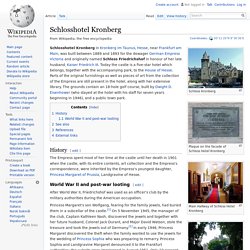
Battle of Hürtgen Forest. The Battle of Hürtgen Forest (German: Schlacht im Hürtgenwald) was a series of fierce battles fought from 19 September to 16 December 1944 between U.S. and German forces during World War II in the Hürtgen Forest about 50 sq mi (130 km2) east of the Belgian–German border.
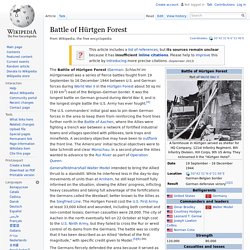
It was the longest battle on German ground during World War II, and is the longest single battle the U.S. Army has ever fought.[4] The U.S. commanders' initial goal was to pin down German forces in the area to keep them from reinforcing the front lines further north in the Battle of Aachen, where the Allies were fighting a trench war between a network of fortified industrial towns and villages speckled with pillboxes, tank traps and minefields.
A secondary objective may have been to outflank the front line. The Americans' initial tactical objectives were to take Schmidt and clear Monschau. Hamburg. Official logo of the Free and Hanseatic City of Hamburg Hamburg (/ˈhæmbɜːrɡ/; German pronunciation: [ˈhambʊʁk], local pronunciation - [ˈhambʊɪ̯ç]; Low German/Low Saxon: Hamborg - [ˈhambɔːx]), officially Freie und Hansestadt Hamburg[4] (Free and Hanseatic City of Hamburg), is the second largest city in Germany and the eighth largest city in the European Union.[5] It is the second smallest German state by area.
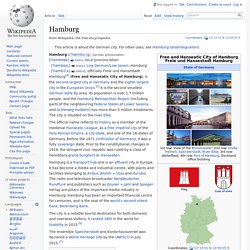
Its population is over 1.7 million people, and the Hamburg Metropolitan Region (including parts of the neighbouring Federal States of Lower Saxony and Schleswig-Holstein) has more than 5 million inhabitants. The city is situated on the river Elbe. Hamburg is a transport hub and is an affluent city in Europe. It has become a media and industrial centre, with plants and facilities belonging to Airbus, Blohm + Voss and Aurubis. Black Forest. Auschwitz concentration camp. German network of concentration and extermination camps in occupied Poland during World War II After Germany invaded Poland in September 1939, sparking World War II, the Germans converted Auschwitz I from an army barracks to hold Polish political prisoners.

The first prisoners, German criminals brought to the camp as functionaries, arrived in May 1940. The first gassing of prisoners, using Zyklon B, a cyanide-based pesticide, took place in the basement of block 11 of Auschwitz I in September 1941. Auschwitz II–Birkenau went on to become a major site of the Nazis' Final Solution to the Jewish Question. From early 1942 until late 1944, transport trains delivered Jews from all over German-occupied Europe to the camp's gas chambers. Potsdam. Hohenzollern Castle. Ancestral seat of the imperial House of Hohenzollern in the Swabian Alps of central Baden-Württemberg, Germany Hohenzollern Castle (German: The first castle on the mountain was constructed in the early 11th century.
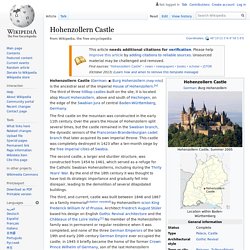
Over the years the House of Hohenzollern split several times, but the castle remained in the Swabian branch, the dynastic seniors of the Franconian-Brandenburgian cadet branch that later acquired its own imperial throne. This castle was completely destroyed in 1423 after a ten-month siege by the free imperial cities of Swabia. The second castle, a larger and sturdier structure, was constructed from 1454 to 1461, which served as a refuge for the Catholic Swabian Hohenzollerns, including during the Thirty Years' War. The third, and current, castle was built between 1846 and 1867 as a family memorial[citation needed] by Hohenzollern scion King Frederick William IV of Prussia.
Wewelsburg. History[edit]
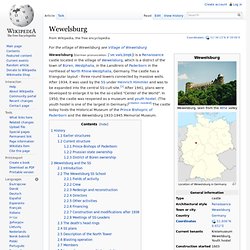
Baden-Baden. Majdanek concentration camp. Unlike other similar camps in Poland, Majdanek was not located in a remote rural location away from population centres, but within the boundaries of a major city (see also: Nisko Plan preceding the formation of the Ghetto).[3] This proximity led the camp to be named 'Majdanek' ("little Majdan") by local people in 1941 because it was adjacent to the city's district of Majdan Tatarski ("Tatar Maidan") in Lublin.

The Nazi documents initially called the site "Prisoner of War Camp of the Waffen-SS in Lublin" because of the way it was operated and funded. It was renamed by RSHA in Berlin as Konzentrationslager on April 9, 1943; however, the local Polish name is how it is remembered.[4] Construction[edit] Concentration camp KL Lublin or the "Konzentrationslager Lublin" in German, was established in October 1941, on Heinrich Himmler's orders forwarded to Odilo Globocnik soon after his visit to Lublin on 17–20 July 1941. In operation[edit] Preserved crematorium ovens (closeup) Death toll[edit] City Palace, Berlin. The Berliner Stadtschloss (or Stadtschloß) in a 19th-century painting The palace was originally built in the 15th century and changed throughout the next few centuries.

It bore features of the Baroque style, and its shape, finalised by the middle 18th century, is attributed to famous German architect Andreas Schlüter, whose first design is likely to date from 1702, though the palace incorporated earlier parts seen in 1688 by Nicodemus Tessin. It served as a residence to various Electors of Brandenburg.